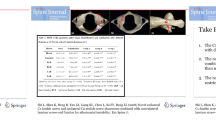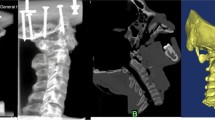Abstract
Purpose
In unique clinical situations where C1–C2 anterior transarticular screw (ATS) fixation is not available or has failed, an anterior transarticular crossing screw (ATCS) with transcorporal pathway of the screws inside the contralateral promontory of C2 may enhance the stabilization and achieve atlantoaxial arthrodesis. The present study was to describe a novel technique of ATCS fixation for atlantoaxial joint instability and its applied anatomy, and compared it with ATS fixation method.
Methods
Direct measurements using digital calipers and a goniometer were conducted on 30 pairs of dried human C1 and C2 vertebrae. The ATS and ATCS with screws (Φ 4.0 mm) were performed on 11 fresh cervical spine specimens. The screw lengths in the C1 and C2, and screw entry angles of the ATS and ATCS were measured, respectively. Cadaver specimens were dissected to observe the incidence of violation to the important structures surrounding the ATS and ATCS fixation technique.
Results
There was enough osseous space for ATCS placement. The lateral and incline angle of the ATCS was 36.2° and 28.7°, respectively. Screw purchase in C2 of the ATCS (25.6 mm) was greater than that of the ATS (11.4 mm). The ATCS C1 purchase (14.8 mm) was similar to the ATS C1 purchase (14.9 mm). No violation to the vertebral artery groove, the spinal canal or the atlanto-occipital joint was observed after the ATCS placement.
Conclusion
Anterior transarticular crossing screw is a feasible and viable option for atlantoaxial fixation in selected cases. This technique achieved remarkable longer screw purchase and could enhance the atlantoaxial stability.





Similar content being viewed by others
References
Barbour JR (1971) Screw fixation in fractures of the odontoid process. S Aust Clin 5:20
Lu J, Ebraheim NA, Yang H et al (1998) Anatomic considerations of anterior transarticular screw fixation for atlantoaxial instability. Spine 23:1229–1235
Reindl R, Sen M, Aebi M (2003) Anterior instrumentation for traumatic C1-C2 instability. Spine 28:E329–E333
Sen MK, Steffen T, Beckman L et al (2005) Atlantoaxial fusion using anterior transarticular screw fixation of C1-C2: technical innovation and biomechanical study. Eur Spine J 14:512–518
Li WL, Chi YL, Xu HZ et al (2010) Percutaneous anterior transarticular screw fixation for atlantoaxial instability: a case series. J Bone Joint Surg Br 92:545–549
Padua MRA, Yeom JS, Lee SY et al (2013) Fluoroscopically guided anterior atlantoaxial transarticular screws: a feasibility and trajectory study using CT-based simulation software. Spine J 13:1455–1463
Koller H, Kammermeier V, Ulbricht D et al (2006) Anterior retropharyngeal fixation C1-2 for stabilization of atlantoaxial instabilities: study of feasibility, technical description and preliminary results. Eur Spine J 15:1326–1338
Cavalcanti DD, Agrawal A, Garcia-Gonzalez U et al (2010) Anterolateral C1-C2 transarticular fixation for atlantoaxial arthrodesis: landmarks, working area, and angles of approach. Neurosurgery 67:38–42
Wang J, Zhou Y, Zhang Z et al (2012) Minimally invasive anterior transarticular screw fixation and microendoscopic bone graft for atlantoaxial instability. Eur Spine J 21:1568–1574
Kansal R, Sharma A, Kukreja S (2011) An anterior high cervical retropharyngeal approach for C1-C2 intrafacetal fusion and transarticular screw insertion. J Clin Neurosci 18:1705–1708
Polli FM, Miscusi M, Forcato S et al (2015) Atlantoaxial anterior transarticular screw fixation: a case series and reappraisal of the technique. Spine J 15:185–193
Xu H, Chi YL, Wang XY et al (2012) Comparison of the anatomic risk for vertebral artery injury associated with percutaneous atlantoaxial anterior and posterior transarticular screws. Spine J 12:656–662
Lapsiwala SB, Anderson PA, Oza A et al (2006) Biomechanical comparison of four C1 to C2 rigid fixative techniques: anterior transarticular, posterior transarticular, C1 to C2 pedicle, and C1 to C2 intralaminar screws. Neurosurgery 58:516–521
Cacciola F, Phalke U, Goel A (2004) Vertebral artery in relationship to C1-C2 vertebrae: an anatomical study. Neurol India 52:178–184
Peng CW, Chou BT, Bendo JA, Spivak JM (2009) Vertebral artery injury in cervical spine surgery: anatomical considerations, management, and preventive measures. Spine J 9:70–76
Finn MA, Apfelbaum RI (2010) Atlantoaxial transarticular screw fixation: update on technique and outcomes in 269 patients. Neurosurgery 66:184–192
Kandziora F, Schulze-Stahl N, Khodadadyan-Klostermann C, Schroder R, Mittlmeier T (2001) Screw placement in transoral atlantoaxial plate systems: an anatomical study. J Neurosurg 95:80–87
Acknowledgments
This study is supported by National Science Foundation of China (No. 81171765).
Author information
Authors and Affiliations
Corresponding author
Ethics declarations
Conflict of interest
None.
Rights and permissions
About this article
Cite this article
Ji, W., Zheng, M., Tong, J. et al. Feasibility and trajectory study of anterior transarticular crossing screw placement for atlantoaxial joint instability: a cadaveric study and description of a novel technique. Eur Spine J 24, 2954–2960 (2015). https://doi.org/10.1007/s00586-015-4135-3
Received:
Revised:
Accepted:
Published:
Issue Date:
DOI: https://doi.org/10.1007/s00586-015-4135-3




